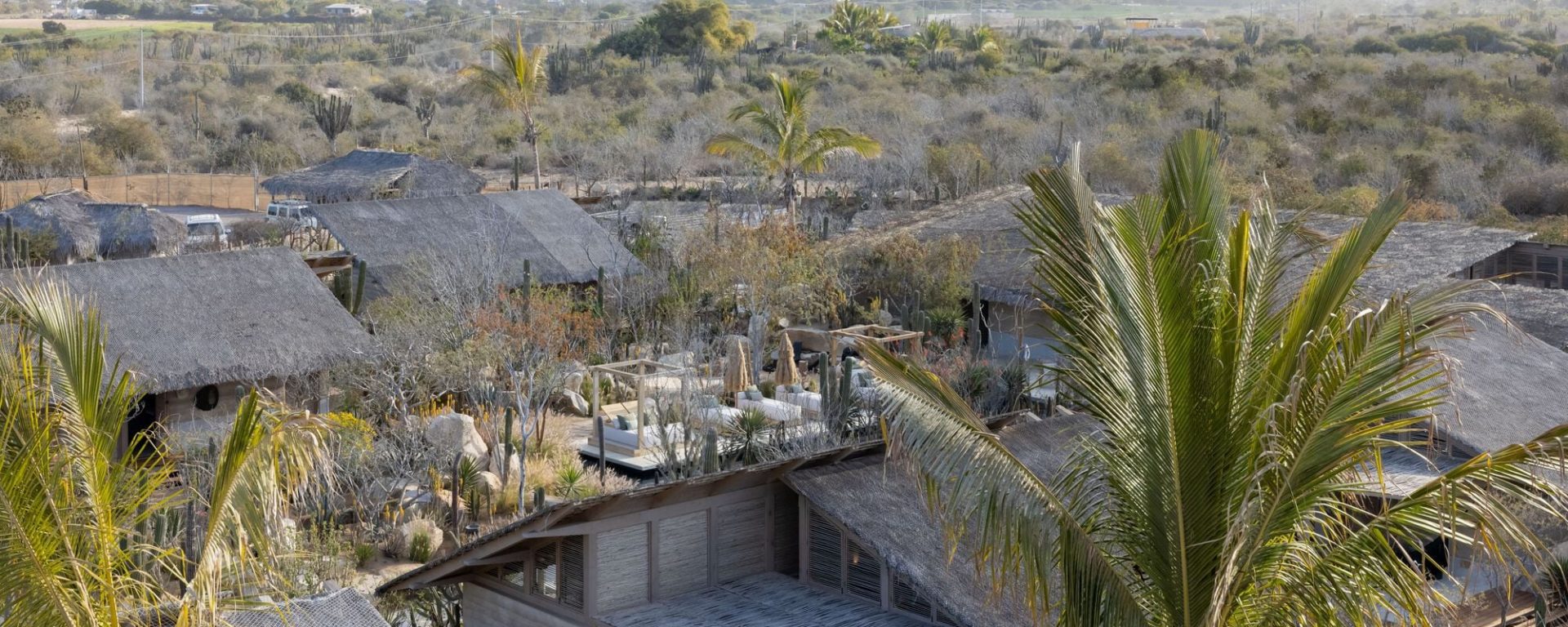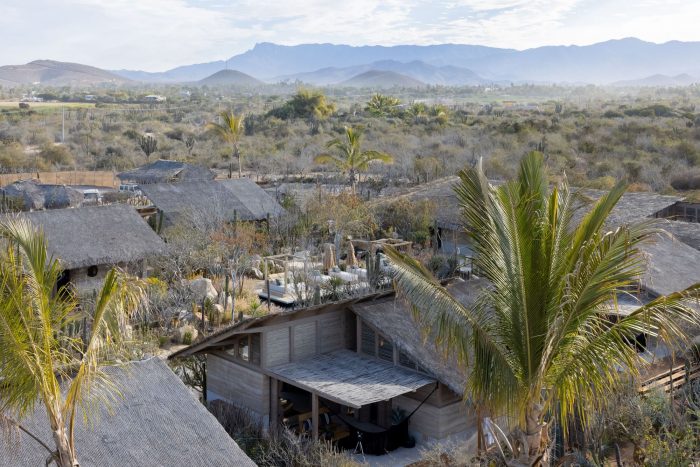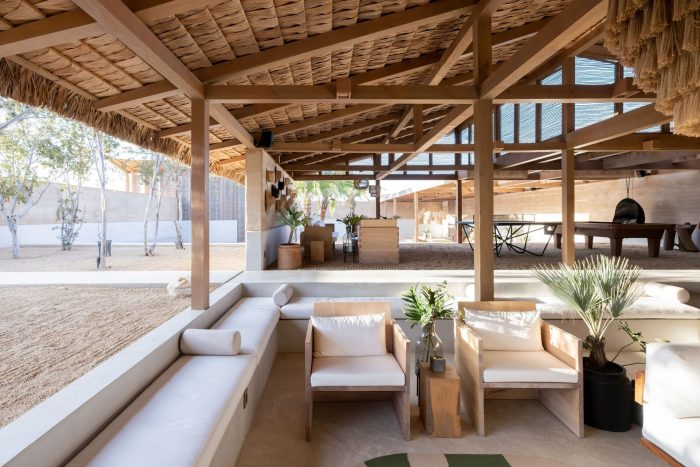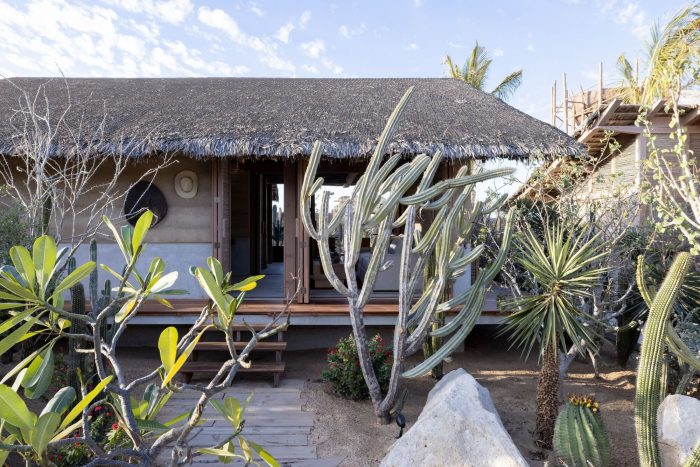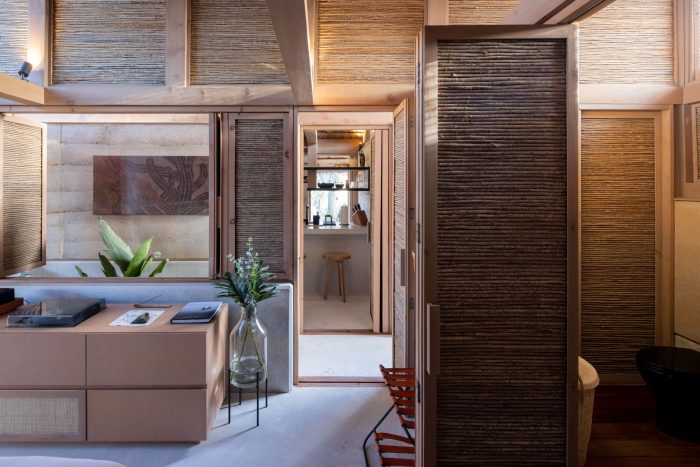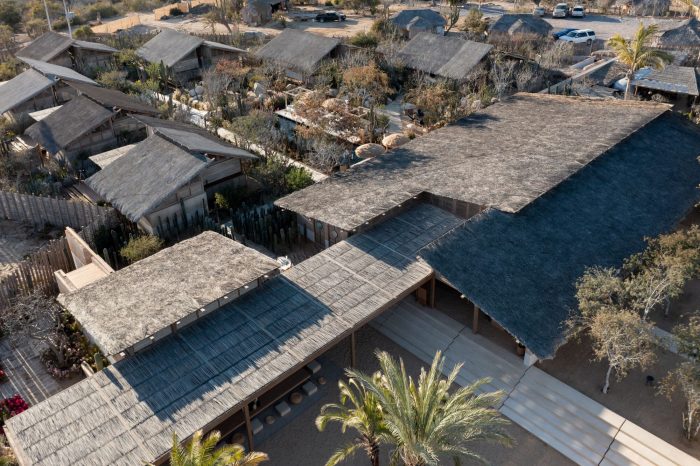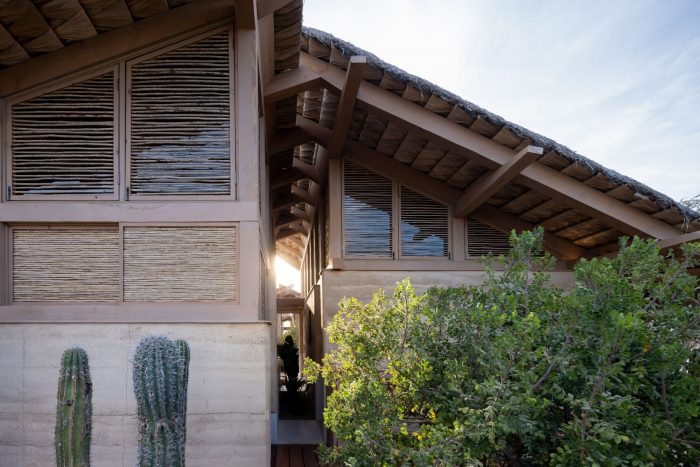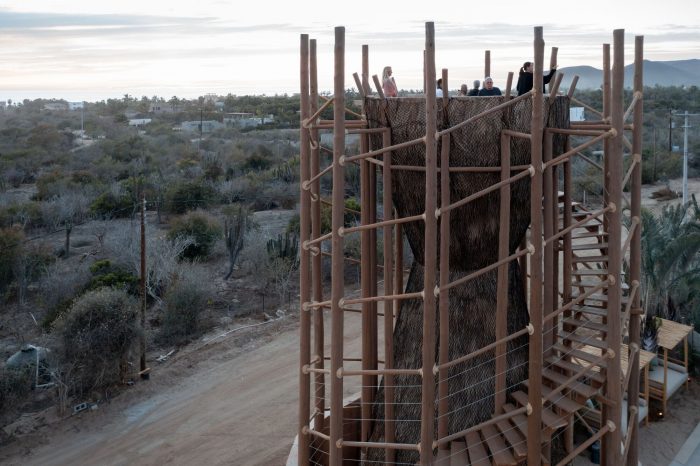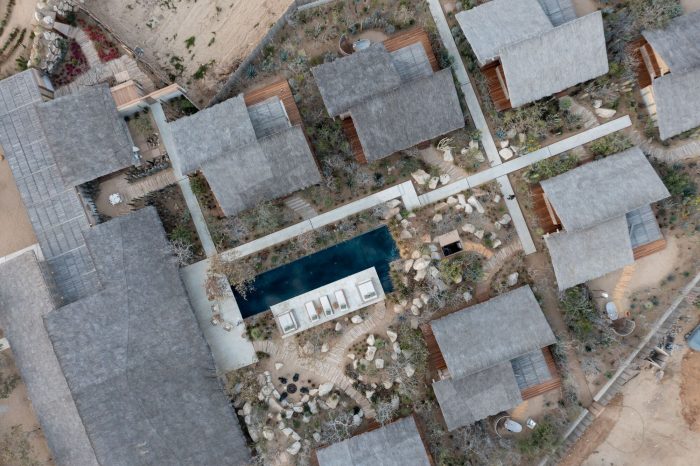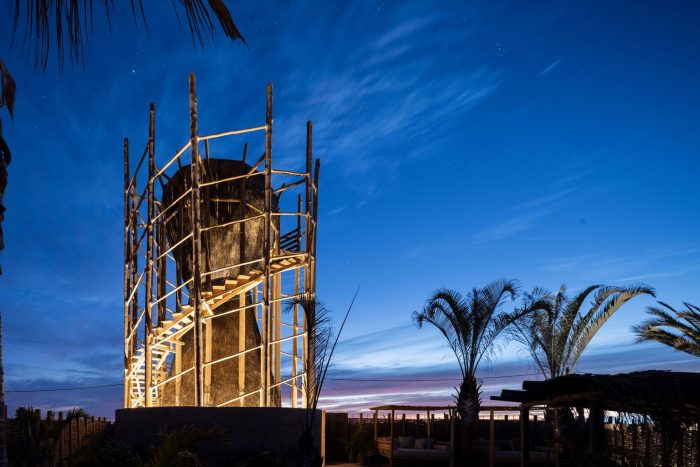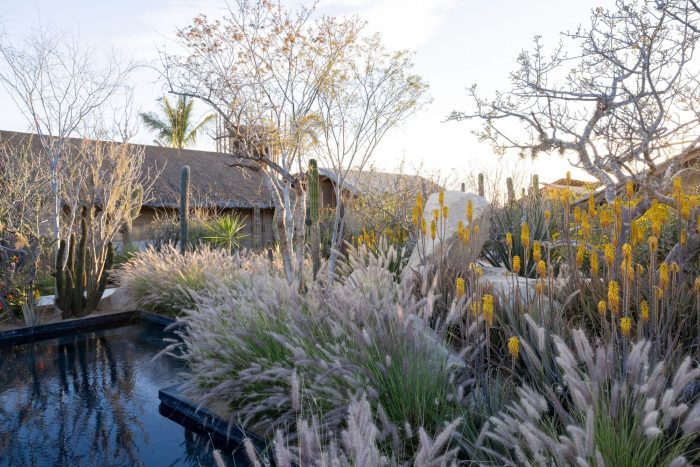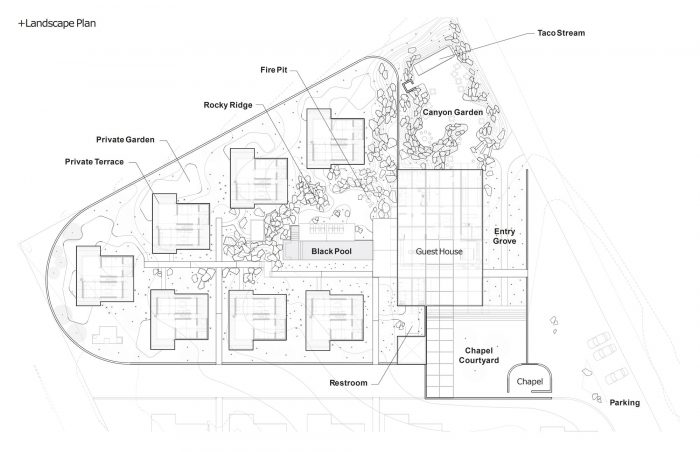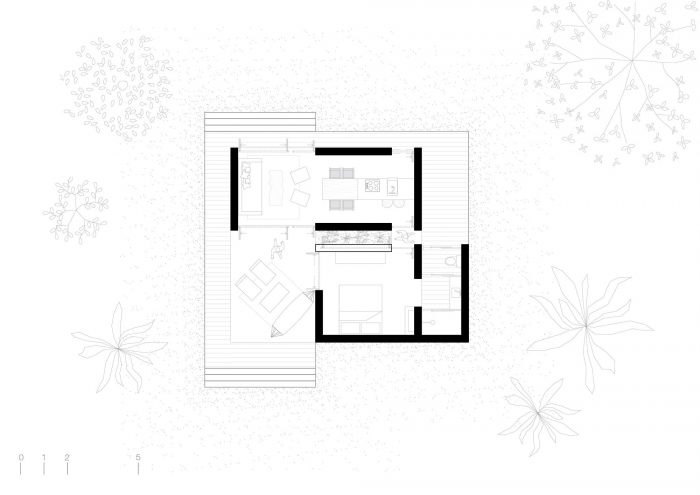沙漠旅游如何能促进领土的可持续发展,以支持环境健康和当地社区的福祉?在一个文化和传统被快速发展加速腐蚀的地区,El Perdido拥抱了南下加利福尼亚的历史根源和物质文化,提供了对过去的一瞥,同时为未来提出了潜在的设计语言。为了消解既定的等级制度,传统的建筑技术在新的应用中被接受,并被重新铸造以促进新的行为。
How might desert tourism foster the sustainable development of territory to champion environmental health and the well-being of local communities? In a region where the corrosion of culture and tradition is being accelerated by rapid development, El Perdido embraces Baja California Sur’s historical roots and material culture, providing a glimpse into the past while suggesting a potential design language for the future. In order to dissipate established hierarchies, traditional building techniques have been embraced in novel applications and recast to foster new behaviors.
El Perdido位于距离太平洋800米的El Pescadero农业小镇,这里有丰富的罗勒、辣椒、西红柿和草莓种植园。这个独特的生态区是由广阔的低矮灌木丛定义的,它穿过沿海冲积平原向西漂移到拉古纳山脉的山脚下。通过气候分析,设计响应了其地理环境的大气条件,并非常注意在客人逗留期间为其提供最佳的热舒适。温度、降水、湿度、风和场地上的太阳入射率都被考虑在内,以采用夏季被动冷却和冬季被动加热的策略。
El Perdido is located 800 meters from the Pacific Ocean in the small agricultural town of El Pescadero which is rich in plantations of basil, chili, tomatoes, and strawberries. The unique ecoregion is defined by expansive low shrubland that drifts across the coastal alluvial plains westward into the foothills of the Sierra de La Laguna mountains. Through a climatic analysis, the design responds to the atmospheric conditions of its geography, and great care was taken to provide guests with optimal thermal comfort during their stay. Temperature, precipitation, humidity, wind, and solar incidence on the site were taken into consideration to employ strategies of passive cooling during the summer and passive heating in the winter.
乡土材料使游客能够与佩斯卡德罗当地的生活方式联系起来,当地的植被、土墙、木质结构和棕榈树屋顶是南下加利福尼亚遗产的缩影。这种调色板在当代开发中通常被忽视,因为进口材料和热带植被,它完全由当地采购的材料定义,并由当地工匠建造。拒绝传统,建筑体验充满了该地区独特的风土人情,同时重新激发了对当地建筑的欣赏。
The vernacular materiality allows the visitor to connect with the local way of life in Pescadero, where the endemic vegetation, earthen walls, wooden structure, and palm roofs epitomized Baja California Sur’s heritage. This palette, typically disregarded in contemporary development for imported materials and tropical vegetation, is defined exclusively by locally sourced materials and built by local craftsmen. Resisting convention, the architectural experience is imbued with the distinct terroir of the region while reinvigorating an appreciation for local construction.
抵达主入口的客人受到一片正式的白棕榈树林的欢迎,这些树在通往中央房屋(招待所)的过程中提供了阴凉。中心屋由生活区、餐厅、供游客使用的厨房吧台、多功能区、当地产品商店和接待处组成,是整个庄园的社会核心和中心发言人。房子的北面是一个餐厅和酒吧,坐落在当地收集的巨石组成的深谷中。南面是一个由低矮的土墙隔开的下沉式庭院,里面有一个安静的喷泉和一个朝东的小教堂。从小教堂向西延伸,是一条被当地植被包围的直线型步行道,将客人带到一个可以看到太平洋全景的观察站。每条步行路线和每个目的地都经过特别调整,以使客人与埃尔佩迪多所处的地区环境相联系。
Guests arriving at the main entrance are welcomed by a formal grove of palo blanco trees that provide shade during the approach to the central house (Guest House). Composed of a living area, dining room, kitchen bar for visitors, multipurpose area, store with local products, and reception, the central house serves as the social nucleus and central spoke to the entire property. To the north of the house is a rΩestaurant and bar resting within a deep canyon of locally collected boulders. To the south, a sunken courtyard delimited by low earthen walls hosts a quiet fountain and an east-facing chapel. Extending west from the chapel is a linear walk surrounded by endemic vegetation that takes guests to an observatory with panoramic views of the Pacific ocean. Each walk and each destination is specifically calibrated to connect guests to the regional contexts in which El Perdido is located.
内部花园有一个狭窄的游泳池,直接连接到中央的房子和一系列的别墅,客人在逗留期间住在那里。每个别墅的设计都是为了促进私密性和社交生活。由卧室、浴室、起居室、餐厅、厨房和阳台组成;这些建筑的配置是为了最大限度地提高效率,同时确保内部空间和周围景观之间的持续对话。其结果是一个可渗透的建筑,室内和室外之间的限制消失了,由土和Palo de Arco制成的墙壁与外面的torotes和yucca融合在一起。
The interior garden has a narrow pool directly connected to the central house and a collection of villas where guests live during their stay. Each villa is designed to promote both intimate and social life. Created by a bedroom, bathroom, living area, dining room, kitchen, and terrace; the buildings are configured to maximize efficiency while ensuring a constant dialogue between the interior space and the surrounding landscape. The result is a permeable building where the limits between the indoor and the outdoor vanish, where walls made of earth and Palo de Arco merge with the torotes and yucca beyond.
“El Perdido是一个完整的体验,一个与周围环境相融合的建筑。它是关于与环境的接触。它是关于选择:与人相处,与自己相处,参观该地区,了解该文化。给予而不是索取。” 联合创始人。
“El Perdido is a full experience, an architecture that blends with the surroundings. It is all about engagement with the context. It is about options: being with people, with yourself, visiting the area, and understanding the culture. To give and not to take. ” Co-founder.
Architects: estudio ALA
Year : 2021
Photographs :Iwan Baan
Lead Architects : Luis Enrique Flores, Armida Fernández
Interior : LASÁL Estudio
Builder : Dylcor Construction
Murals : Rodrigo Roji, Cristian Poire
Branding : Jorge Martínez
Landscape : Fletcher Phillips
City : Todos Santos
Country : Mexico

